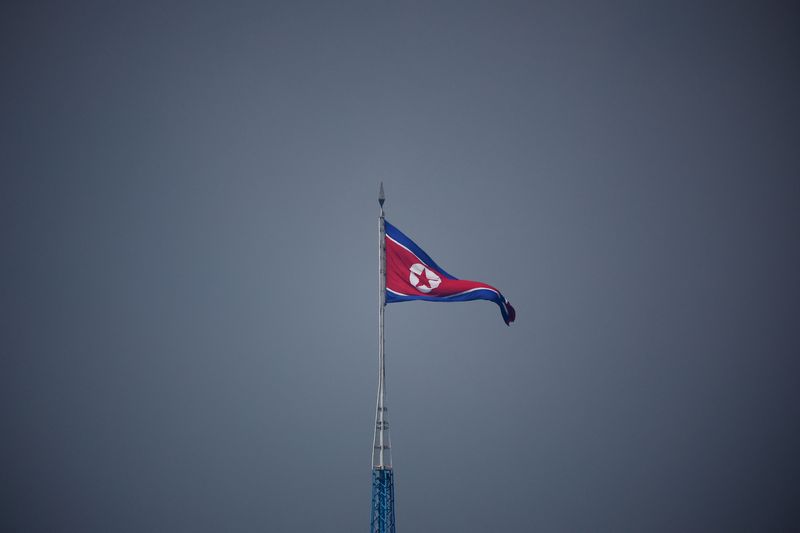
© Reuters. FILE Photograph: A North Korean flag flutters at the propaganda village of Gijungdong in North Korea, in this photograph taken in the vicinity of the truce village of Panmunjom within the demilitarized zone (DMZ) separating the two Koreas, South Korea, July 19, 2022. REUTER
By Joori Roh and Chang-Ran Kim
SEOUL/TOKYO (Reuters) -North Korea fired two short-selection ballistic missiles into the sea on Thursday in the course of Japan, as a U.S. plane carrier and allied warships held a drill that simulated the capturing down of a single of the North’s missiles.
North Korea has released about 40 missiles this year, which include its most significant intercontinental ballistic missiles (ICBMs), and seems all set to hold its initial nuclear check because 2017, officials in Seoul and Washington have explained.
Thursday’s launches followed the return of the provider, USS Ronald Reagan, to waters off the Korean peninsula, and a U.N. Safety Council assembly held in response to the North’s current checks.
The missile start was the sixth in 12 days and the to start with considering the fact that North Korea fired an intermediate-vary missile (IRBM) over Japan on Tuesday, which prompted joint South Korean and U.S. missile drills in which just one weapon crashed and burned.
The start was noted by South Korea’s Joint Chiefs of Personnel and the Japanese govt.
“This is the sixth time in the limited period, just counting the kinds from the conclusion of September,” Japanese Prime Minister Fumio Kishida explained to reporters. “This completely are not able to be tolerated.”
The launch came about an hour immediately after North Korea condemned the United States for conversing to the United Nations Safety Council about Pyongyang’s “just counteraction actions” on joint South Korea-U.S. drills, suggesting its missile tests are a reaction to the allied military services moves.
In a statement, the reclusive nation’s foreign ministry also condemned Washington for repositioning the U.S. plane provider off the Korean peninsula, saying it posed a severe threat to the security of the situation.
The carrier and its strike group of accompanying warships was abruptly redeployed in response to North Korea’s IRBM launch above Japan.
The provider strike team joined destroyers from South Korea and Japan in maritime missile protection education, the South Korean military services explained on Thursday.
“This training focuses on mastering detection, tracking and interception processes by way of shared target facts beneath a situation of (North Korea) conducting ballistic missile provocations,” it mentioned in a assertion.
South Korea said it scrambled jets on Thursday after observing at minimum 12 North Korean warplanes traveling in formation on an obvious bombing drill, the Yonhap information agency described.
A Condition Office spokesperson stated the United States condemned Thursday’s launch as a violation of the United Nations Safety Council resolutions and a risk to regional neighbours and the intercontinental neighborhood.
The spokesperson, even so, extra that Washington was fully commited to a diplomatic solution and named on the North to interact in dialogue.
On Wednesday, the United States accused China and Russia of enabling North Korean leader Kim Jong Un by blocking tries to improve U.N. Safety Council sanctions on Pyongyang for its nuclear weapons and ballistic missile packages.
South Korean President Yoon Suk-yeol and Kishida agreed during a telephone connect with on Thursday that a clear message ought to be despatched to North Korea that its provocation would deliver consequences, Yoon’s office explained.
The leaders condemned the North’s latest missile checks as functions of really serious provocation and urged a halt to these types of reckless provocation, it additional.
Tokyo lodged a “vehement protest” with North Korea more than Thursday’s launches by means of delegations in Beijing, Japanese Protection Minister Yasukazu Hamada claimed.
“North Korea has relentlessly and unilaterally escalated its provocation specifically because the beginning of this calendar year,” Hamada informed reporters.
Thursday’s very first missile likely flew to an altitude of about 100 km (62 miles) and a assortment of 350 km (217 miles), though the next experienced an approximated altitude of 50 km (31 miles) and coated 800 km (497 miles), probably getting an irregular trajectory, he stated.
South Korea’s JCS said the missiles were released from in close proximity to the North Korean cash of Pyongyang.
The United States and its allies have stepped up displays of military drive in the region, but there appears minor prospect of additional global sanctions by the U.N. Safety Council, which has by now handed resolutions banning the North’s missile and nuclear progress.
China’s deputy U.N. ambassador, Geng Shuang, mentioned the Security Council desired to perform a constructive role “as an alternative of relying exclusively on potent rhetoric or stress.”
In May perhaps, China and Russia vetoed a U.S.-led force for more U.N. sanctions on North Korea over its renewed ballistic missile launches, publicly splitting the Stability Council for the 1st time considering that it started punishing Pyongyang with sanctions in 2006.

